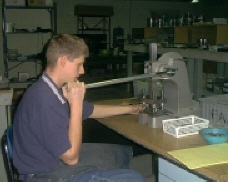I posted this on another thread but wanted to send this separately in case anyone misses it.
First....get a Whitney 91 punch, it is a 10 ton (TEN ton) hand operated punch press, bench mounted. Cuts through 3/32" forbon like a hot knife through butter. They weigh about 90 pounds and don't cost too much when you can find them. I bought 2 for $100.00 each.
Cut forbon into strips the short width of the finished piece (about .98" or whatever it is).
Create trimming and parting dies to punch the shape out of the strip. The width of the strip takes care of two sides of the finished piece. You have to punch only the other two sides.
In all cases, the sides of the forbon pieces (strat and tele top and bottom) are symmetrical.
You create the dies out of sections of tool steel bolted together. The punch portions you create out of tool steel mounted in a carrier.
Since the sides are symmetrical, you profile a piece of tool steel about 12 - 18 inches long, and cut the punch pieces (think slices of bread) as you need them, harden and grind to finished shape, and mount in a carrier.
You create the punch with a degree of "shear" so the full 10 tons is concentrated on a portion of the punch as it travels down through the material...NOT on the whole blank at the same time. Think large paper cutter.
You can punch 1/4 in holes in thick forbon with a good hole puncher. It isn't dead easy but I've done it to determine what kind of effort / power is needed. Use the same principles to design a multiple hole puncher using a Whitney 91 punch for power.
What you have to figure out is how to exactly shape and grind the punch and die to provide the proper clearance to produce the blank to the size you want it.
Obtain and figure out how to use a surface grinder. Without it your efforts may well be futile. With it, you can make just about anything you will need, punch, die and mold-wise.
I have given you a boat load of ideas. The rest you will have to figure out. No more hints. This is the basis of why the punches and dies cost so much to have made for each part you need to make. They are built to last and be maintained by a tool and die maker.
I have mentioned sources of information on these forums before.
DoctorX
First....get a Whitney 91 punch, it is a 10 ton (TEN ton) hand operated punch press, bench mounted. Cuts through 3/32" forbon like a hot knife through butter. They weigh about 90 pounds and don't cost too much when you can find them. I bought 2 for $100.00 each.
Cut forbon into strips the short width of the finished piece (about .98" or whatever it is).
Create trimming and parting dies to punch the shape out of the strip. The width of the strip takes care of two sides of the finished piece. You have to punch only the other two sides.
In all cases, the sides of the forbon pieces (strat and tele top and bottom) are symmetrical.
You create the dies out of sections of tool steel bolted together. The punch portions you create out of tool steel mounted in a carrier.
Since the sides are symmetrical, you profile a piece of tool steel about 12 - 18 inches long, and cut the punch pieces (think slices of bread) as you need them, harden and grind to finished shape, and mount in a carrier.
You create the punch with a degree of "shear" so the full 10 tons is concentrated on a portion of the punch as it travels down through the material...NOT on the whole blank at the same time. Think large paper cutter.
You can punch 1/4 in holes in thick forbon with a good hole puncher. It isn't dead easy but I've done it to determine what kind of effort / power is needed. Use the same principles to design a multiple hole puncher using a Whitney 91 punch for power.
What you have to figure out is how to exactly shape and grind the punch and die to provide the proper clearance to produce the blank to the size you want it.
Obtain and figure out how to use a surface grinder. Without it your efforts may well be futile. With it, you can make just about anything you will need, punch, die and mold-wise.
I have given you a boat load of ideas. The rest you will have to figure out. No more hints. This is the basis of why the punches and dies cost so much to have made for each part you need to make. They are built to last and be maintained by a tool and die maker.
I have mentioned sources of information on these forums before.
DoctorX


Comment